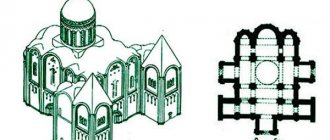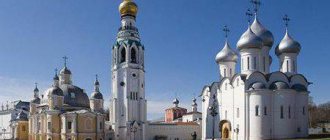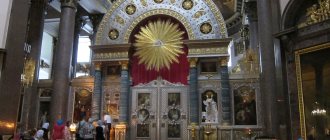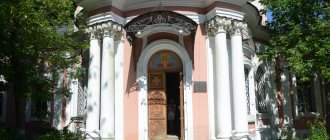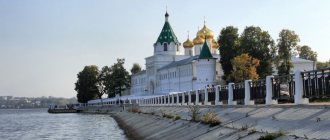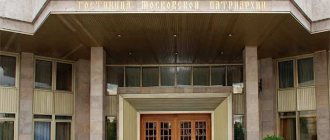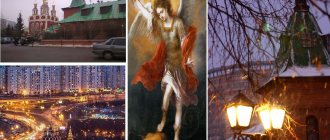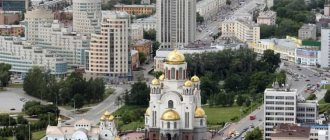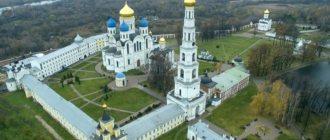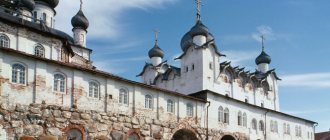On Saratov's Museum Square stands the ancient Holy Trinity Cathedral. They heard its walls and the whistling of Tatar arrows, and the hubbub of Pugachev’s multilingual gang, and the hoarse voices of revolutionary speakers calling for “destroy to the ground and build...”, however, what exactly needed to be built, they themselves had a vague idea. Much was destroyed irrevocably by them, but a marvelous temple was reborn from darkness and desolation - the beauty and pride of the Volga region. The story of his birth should begin by going back four centuries.
Wooden predecessor of the cathedral
In 1590, under the pious sovereign Fyodor Ioannovich, the archers founded a guard city on the banks of the Volga, called Saratov. There is no information preserved about which churches the Orthodox people prayed in in the first decades of its existence, but it is known for certain that in 1674 Bishop Parthenius of Astrakhan blessed the construction of a wooden church in the name of the Holy Trinity on the only city square at that time.
Through the diligence of the parishioners, it was erected on the very spot where the Trinity Cathedral, famous throughout the country, now stands (the city of Saratov). The church served for ten years to save human souls, but in 1684 the Lord allowed a large fire to happen in Saratov - a frequent visitor to all Old Russian wooden cities - and the fire destroyed the defenseless log church.
Only firebrands remained in the place of the church - grief for the parishioners, and ruin for its rector, Archpriest Ignatius (Danilov). And they went to beat the Astrakhan Metropolitan Savvaty, so that he would allow the construction of a stone cathedral, and would back up his archpastoral blessing with money, of which such a task required an enormous amount.
To help pilgrims
Pokrovsky is open from 8.00 to 16.00. On weekdays, the Liturgy is celebrated at 8.00; on Sundays and holidays, parishioners can attend the early morning service at 7.00, and the late Liturgy at 9.00. Evening services are held at 17:00 every day.
Divine service in the Church of the Intercession
The schedule of services of the Intercession Cathedral in Saratov can be found on the church website. On Monday and Friday after the service, parishioners pray during a water prayer service.
At the Saturday service at 16.00, the Akathist is read before the holy image of the Mother of God, “The Inexhaustible Chalice.”
Construction of a stone building
Well, we don’t know about the money, but the bishop gave his blessing, and even indicated what features the future cathedral should differ from its counterparts, many of which had been erected by that time in Holy Rus'. With the receipt of the metropolitan's charter, work in the city square began to boil, and the entire Orthodox Saratov took part in it. The Trinity Cathedral was built not only with public funds, that is, voluntary donations from the townspeople, but also with their own hands. It is known that all work that did not require special qualifications was carried out by the future parishioners themselves.
Upon completion of construction in 1659, Archimandrite Joseph was sent from Astrakhan, who examined the new cathedral with all rigor and at the same time consecrated both of its churches - the upper one, in the name of the Most Holy Trinity, and the lower one, in honor of the Dormition of the Blessed Virgin Mary. The acceptance certificate drawn up by the meticulous archimandrite has survived to this day. It lists in detail all the design features of the building, and most of all pays attention to the luxurious and very rare for provincial churches Dutch oven, installed on the ground floor and covered with “wonderful tiles.”
Reviews about the temple
What do travelers say about the Holy Trinity Cathedral? Saratov, reviews of which are mostly positive, is famous primarily for this church, built in the Moscow Baroque style. For a believer, this is the House of God. Parishioners and pilgrims come here to worship numerous shrines. But people who are far from believing in the other world will also be interested in looking at the icons of Christ the Savior and Our Lady of Kazan - they are of historical and cultural value. Around the cathedral there is a beautiful garden with rose bushes and a pond in which goldfish swim.
New fires and disasters
But the stoves, which bring warmth and comfort into homes, were also fraught with real danger. So in 1712, a burning coal fell from under someone’s cast-iron damper, and Saratov, most of whose buildings were still wooden, flared up again. This fire went down in history as the most terrible and destructive of all that happened in the city since its foundation.
A contemporary described with pain what the fire had transformed the city’s main shrine into. The roof, window frames, doors and all other wooden parts of the building were completely burned, leaving only a stone skeleton covered with soot. The rich interior decoration of the cathedral, made up of donations from God-loving parishioners, also perished.
However, who in Rus' will be surprised by this? The history of most ancient temples is a continuous series of fires and subsequent restorations. So in Saratov, the Orthodox people, having grieved, reached into their money boxes for nickels and hryvnias to repair the shrine. God's work cannot be denied.
Shrines
The most ancient landmark of the Trinity Cathedral in Saratov is the holy image of the Savior Not Made by Hands, it is also called the Streletsky Intercessor or the Trinity Savior.
The main shrine of the city is its guardian. The icon of the Savior not made by hands from the day the cathedral was founded is located within the walls of the temple. There are always people around the great shrine, the piercing gaze of the Savior does not leave a single soul indifferent, repentance, purification and special grace come.
Temple icon of the Holy Trinity in Saratov Cathedral
Pilgrims and parishioners bring their prayers to the icons of the Mother of God:
- Kazan;
- Iverskaya;
- Augustovskaya.
The holy images of Saints Innocent, Basil the Great, Spyridon of Trimifuntsky, St. Nicholas the Wonderworker, Seraphim of Sarov and many others to this day give prayer workers miracles of healing and answers to troubling problems. There is always a crowd around the ark with the relics of the holy righteous, God's saints.
Interesting! The Lower Assumption Church is the custodian of a reliquary with 132 parts of holy relics. The Athonite brethren handed over to the Saratov Orthodox pearl several holy images of the Mother of God, among them “Quick to Hear,” “Seeking the Lost,” and “Iverskaya.” The icon of the healer Panteleimon was also brought from the holy Mount Athos.
Risen from the ashes
Revived after the fire, the Saratov Trinity Cathedral looked better than before. The refectories on the lower and upper floors were extended and connected by arches. At the top of the building they built a covered gallery and, most importantly, a bell tower. At that time, it not only summoned pilgrims with the ringing of bells, but also served as an observation post from which they monitored the possible approach of the Tatars, who until 1717 repeatedly launched raids and devastated the suburbs.
The reconstruction of the cathedral, which was a consequence of the fire, lasted more than ten years. An event that went down in the history of Saratov is connected with it. In 1722, while setting out on a Persian campaign, Tsar Peter the Great and his wife Empress Catherine I visited him while passing through. The city archives contain records that the tsar personally climbed the scaffolding that covered the cathedral building, and, as is known, had skill in carpentry and construction, gave very practical instructions.
In 1774, the Lord sent new trials to the people of Saratov. In May, another fire broke out in the cathedral, which had been rebuilt by that time, severely damaging the upper church, and in the summer the city survived the invasion of Pugachev, who approached it at the head of an army of thousands. Most of those residents who fled into the forests and thereby escaped death, returning, found only ashes on the site of their former homes, and of those who remained in the city, trusting in the will of God, many said goodbye to life, becoming victims of “senseless and merciless" riot that swept through Saratov, among other cities. The rioters, however, did not touch the Trinity Cathedral.
Great Russian "maybe"
The next stage in the history of the cathedral covers the period from 1786 to 1811 and is a very characteristic illustration of Russian life. The fact is that in the mid-eighties, cracks appeared on the facade of the building and gradually began to increase in size - an obvious result of design errors or construction defects. Since in this state the cathedral was dangerous (it could collapse at any moment), the ruling bishop sent the governor an order to completely dismantle the dangerous building and erect a new one in its place.
It is quite clear that only dismantling a huge stone structure requires considerable funds, and even more so for the construction of a new one. However, the bishop's letter contained many good wishes, but not a word was said about money. The residents of the city, with all their piety, could not collect such a sum.
Therefore, it was decided, relying on the Will of God and the great Russian “maybe,” not to close the cathedral, but to continue services there, especially since everyone had become accustomed to it over the years. So the Saratovites prayed, glancing warily at the ceilings, until 1795, when an official arrived from the Astrakhan Consistory with the strictest instructions to immediately seal the temple.
The cathedral remained locked until 1800, when the townspeople decided: since it had not yet collapsed, the Lord would carry it further. The seals were removed, services were resumed, but a committee was established at the temple, consisting of honorary citizens of the city. His duties included regularly inspecting the walls and giving an official conclusion whether they were crawling or not. For eleven years, venerable men compiled technical reports in which the only justification for the continuation of the temple’s work was God’s mercy.
Finally, in 1811, the local salt industrialist and rich man M.A. Ustinov, at his own expense, carried out work to strengthen the building. Powerful vertical ribs were attached to its walls - buttresses, hidden from view by a covered gallery and a two-story porch built above them. Thanks to his efforts, the wooden roof covering was replaced with iron, and new rich iconostases were installed inside. This marked the end of a period that lasted exactly a quarter of a century, during which the cathedral was either closed - it would collapse, or reopened - God is merciful. This time it passed - it would always be like this!
Temple in honor of the icon of the Mother of God “Quench my sorrows” in Saratov
One of the important attractions of Saratov is the temple located in the city center, built in honor of the icon of the Mother of God, called “Quench My Sorrows”.
It was erected at the beginning of the twentieth century at the Bishop's House according to a design that is actually a copy of St. Basil's Cathedral, only slightly smaller. And the main temple icon of the church, as legend says, was an exact copy of the miraculous prototype of the Mother of God from Holy Mount Athos.
Divine services were held in the church until January 1930, after which its building was given over first to the Mother and Child Home, and then to the planetarium.
In 1965 the church was restored, and in 1990 it was returned to the church. Between 2005 and 2009, large-scale restoration work was carried out in the church building. Nowadays this Saratov church has the status of an object of cultural regional heritage.
The cathedral's prosperous period
In 1826, a new cathedral was built and consecrated in the city in honor of the holy noble prince Alexander Nevsky. From then on, it was the center around which Saratov built its spiritual life. Trinity Cathedral became an ordinary parish church, but, having won the love of Saratov residents over the long years of its history, it enjoyed their affection and, importantly, donations. So, in 1836, the merchant of the first guild F. Ya. Pulkin added side chapels to both refectories of the temple, which were dismantled during the Soviet period and have not survived to this day.
The beginning of the 20th century was marked by preparations for major work to rebuild and reconstruct the temple. To implement them, a committee was created headed by the vice-governor of Saratov, actual state councilor V.N. Azancheev-Azanchevsky, and his deputy, the rector of the church, Archpriest Gennady (Makhrovsky). The committee developed a plan for construction and restoration work, the implementation of which was prevented by the events of 1917 that overwhelmed Saratov.
Current state
Restored inside and out, the Trinity Cathedral is now a spiritual shrine, under the care of which is the entire city.
Social work of churched Christians led by priests includes:
- teaching Sunday school to children and adults;
- the opportunity to participate in an amateur choir;
- providing charitable assistance to the needy and sick;
- bell ringer training classes.
All interested Christians can join the volunteer effort; a museum is open here.
Years of total atheism
Trinity Cathedral was located on the square, which during this period became the center of the city's political life. It constantly hosted revolutionary and anti-religious rallies, followed by rallies of various organizations and movements, including such a notorious one as “Down with Shame!”, which proclaimed physical nudity as the only possible form of equality.
Having survived the invasion of Pugachev in the 18th century, Saratov again plunged into a nightmare of tyranny and lawlessness. Massive arrests of representatives of the clergy and the most active parishioners began. In September 1919, the rector of the Trinity Cathedral, Archpriest Gennady (Makhrovsky), and a number of other clergy were shot without trial, and a month later the ruling bishop of the Saratov diocese and many of his entourage received the martyr’s crown.
Already in the early thirties, almost all the churches of Saratov ceased their work, many of them were destroyed. The Holy Trinity Cathedral was also closed. The city of Saratov became the arena of an atheistic campaign unprecedented in its scale and savagery. The monument of temple architecture, which by that time had more than three centuries of history, was first used as a warehouse, and then designated for demolition as being of no interest to members of the new socialist society.
Moscow Baroque
The Holy Trinity Cathedral (Saratov) and its bell tower initially stood separately from each other. The temple was semicircular, ship-type, with an altar in the form of an apse. According to the layout, the building was an “octagon mounted on a quadrangle.” This form is often found in Russian church architecture. The squat, static and massive “four” is balanced by the “eight” directed into the sky. The rich decor and plasticity of forms classify the Saratov Holy Trinity Cathedral in the Moscow Baroque style. The bell tower was connected to the temple only after reconstruction in 1837. It also represented an octagon on a quadruple in its layout. The bell tower was crowned with an octagonal tent. This tower appears light and graceful thanks to the cross-shaped windows with equal rounded ends. In the twenties of the eighteenth century, the belfry, in addition to bells, also acquired chimes.
Fight for the temple
And he would have shared the fate of many churches of God irretrievably lost by Russia, but there were people who were not afraid to vote in his defense. These were not only parishioners, but the best part of the city intelligentsia. The main initiative was shown by employees of Saratov University and employees of city museums. On their part, this was a manifestation of unparalleled civic courage, since in those years any actions directed against the general line of the party, which included the fight against religion, were considered anti-state and could lead to the most tragic consequences.
But their struggle was crowned with success - the Trinity Cathedral of Saratov survived, although it remained inactive. This continued until the difficult situation on the fronts of the Great Patriotic War forced the government to reconsider its attitude towards religion, seeing in it a powerful force capable of uniting the people and giving them the strength necessary to defeat the enemy. It is known that during these years many churches, previously closed and used for economic needs, became operational again.
In October 1942, the Trinity Cathedral (Saratov) also resumed work. A description of his those years can fill the heart of every person with pain - not only a believer, but also someone who simply relates with trepidation to their own history. The atheist vandals, in whose hands it had been for many years, broke the iconostasis, plundered the sacristy, and destroyed liturgical books and icons.
However, the fervent prayer of the parishioners warmed the devastated and cold Trinity Cathedral (Saratov). The schedule of services - a small piece of paper that appeared on his door - became the first sign of spiritual spring, the time of which was bound to come. And she was getting closer. Her messengers were thousands of people who came to the temple in the first post-war years, most of whom were yesterday's front-line soldiers.
The restoration of the interior of the cathedral lasted for many years. The reason for this was the extreme poverty of the people. People brought to the temple only those small funds that they could hardly find from their meager household budget, but this money was shamelessly seized by government officials to replenish the “Soviet Peace Fund.”
Significant improvements came only in the early fifties, when the famous Palesian artist P. L. Parilov painted forty icons for the cathedral, which were included in the iconostasis of the upper and lower churches. By this time, many façade works had been completed. Until the end of the eighties, the Trinity Cathedral (Saratov), photos of which are presented in the article, remained one of the two operating city churches.
Choir
The main reason why many people come from afar to visit the Holy Trinity Cathedral (Saratov) is Christmas services. The choir of this temple is famous far beyond the region. Even after the October Revolution, the traditions of church Orthodox singing were not forgotten, but were carefully preserved and developed. Despite troubles at work, many Saratov musicians considered it their Christian duty to sing in the cathedral choir. Now there are several singing groups in the temple: an amateur one (male and female) and two professional ones. One performs the choir on weekdays, and the second only on church holidays. Even atheists come to the cathedral to listen to this last one. The choir consists of thirty people. All singers have higher musical education. The choir often performs on tour in other cities of Russia and abroad. But on holidays he always returns to the Holy Trinity Cathedral (Saratov). Christmas and Easter services on the occasion of the Dormition of the Mother of God and the Descent of the Holy Spirit are held under their mellifluous singing.
Good changes of the nineties
An important event in the life of the Trinity Cathedral was the visit of His Holiness Patriarch Alexy II in 1993 and the Divine Liturgy he performed - the first in the four-century history of Saratov, which was served there by the Primate of the Russian Orthodox Church.
However, in order to achieve its current splendor, repeating its previous appearance in every detail, the Trinity Cathedral (Saratov) had to go through a long and difficult path. His working hours were still limited. But perestroika has already introduced into the life of the country a new, or rather, an old, pre-revolutionary attitude towards religion and issues of faith. Thanks to this, everyone was able to decide for themselves what the road to the temple means to them and what shrines they are ready to worship.
Freedom of conscience is no longer an empty declaration. But perestroika brought with it many problems, including material ones. Throughout the country, churches that had been taken from them were returned to believers, and their restoration required significant funds that were not available in city budgets. Saratov did not have them either. Trinity Cathedral, the history of construction and decoration of which is inextricably linked with voluntary donations from parishioners, was also in poverty.
Changes came with the appointment of a new ruling bishop to the Saratov diocese - Bishop Longin (Korchagin), who managed to find material resources in a short time, and agree with the Ministry of Culture of the Russian Federation on drawing up a project for restoration work, and find the necessary specialists. But the main role, as always, was played by the parishioners, who helped to the best of their ability and ability - some with rubles, and some by doing feasible work.
Today, among the numerous Russian churches, the Trinity Cathedral (Saratov) has taken its rightful place. The schedule of services posted at the entrance indicates that services there are conducted in full, as provided for by the church charter, as it was before, in the pre-revolutionary years. Once again, its doors are wide open for everyone who is looking for their path to God, and there are more and more of them every day.
Description of the upper tier
Restoration work here lasted much longer. It was necessary to put the “octagon” in order, as well as the covered gallery above the buttresses, the domes and the bell tower. The work was completely completed only in 2014. The upper temple was, as before, consecrated in honor of the Life-Giving Trinity. Here, as in the lower tier, the iconostasis was completely replaced, and the walls were painted. All small architectural details of the interior were re-done. Patriarch Kirill came to the Holy Trinity Cathedral (Saratov) for the consecration. This was during the Primate's visit. After the service, Kirill issued a patriarchal decree. In it, he returned the temple to the status of the cathedral of Saratov. But now it is officially called “The Descent of the Holy Spirit.” There are two churches inside the cathedral. The upper one bears the former name of the temple - Holy Trinity, while the lower one is called Assumption.
